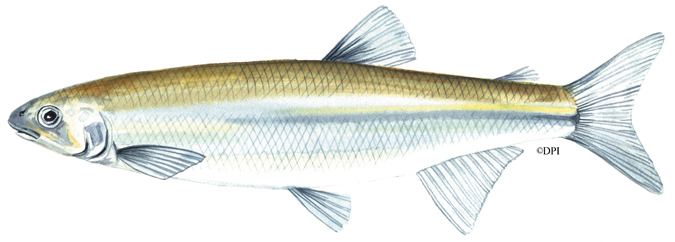Australian grayling

| Common Name: | Australian grayling |
| Other Name/s: | Cucumber mullet, cucumber fish, Yarra herring |
| Family: | Prototroctidae |
| Scientific Name: | Protroctes maraena (Gunther, 1864) |
| Origin: | Native |
Conservation Status
State: Classified as 'threatened' under the Flora and Fauna Guarantee Act 1988.
Federal: Classified as 'vulnerable' under the Environment Protection and Biodiversity Conservation Act 1999.
Description
Slender body with a small head. Large eyes, usually bright yellow; rounded snout. Lower jaw is shorter than the upper jaw. Adipose fin. Mouth reaches to below the eye. No scales on the head and no lateral line. Brownish to olive or grey on the upper body, lighter on the sides, belly is usually white or yellowish. Peculiar cucumber smell given off by freshly caught fish.
Distribution
Coastal drainages from the Hopkins River eastwards. Can occur well inland in these streams. Once common in all waters, it is still abundant in some localities.
The Australian grayling was considered extinct in Victoria pre 1970 because the population once abundant in the Yarra River (and fished by anglers) appeared to have diminished.The start of wide-ranging fish surveys by the Fisheries and Wildlife Department in the early 1970's found good numbers of grayling first in the Combienbar River in Gippsland, then in almost all coastal waters west of the Hopkins River. Very large populations were found in the Mitchell, Tambo and Barwon Rivers. Surveys revealed that they still occurred in the lower Yarra River and should now recolonise upstream since a fishway has been constructed at Dight's Falls.
Habitat
River and streams with a cool, clear, moderate flow, with a gravel substrate and alternating pools and riffles.
Brief Biology
Known to reach 33cm in length, most common at 17-19cm. Believed to be omnivorous, taking insect larvae of various types, small crustaceans, and plant material. Matures sexually at 1-2 years of age and 15cm, females appear to mature after 2 years in fresh water, producing an average of 47,000 eggs.
Complete life-cycle is not known, but current view is that spawning takes place in the freshwater mid-reaches of streams during late April-early May. Eggs are scattered over the substrate and newly hatched larvae are presumed to be swept downstream to brackish water where they remain for
about 6 months.
Newly-hatched fish are known to react strongly to light, preferring shady areas.
During November juveniles ascend to the mid-reaches of the river where they spend the rest of their lives. Evidence indicates that the majority of grayling die before or during their
third year.
Other Notes
Considered an endangered species in the 1970's and early 1980's, but recent investigations indicate that while it may be locally rare it occurs over a wide area. Has recently been confirmed again in several locations in the Yarra River.
The apparent decline-abundance cycles in grayling may reflect the species complex life cycle and high fecundity. Several difficult environmental years in succession (typical of Australia's drought-flood cycles) could have serious effects on grayling populations, but survivors could explosively repopulate during favourable years.
A very common fish a century ago, populations declined dramatically during the last half of the 19th century, probably as the result of the impact of man on habitat, stream regulation and siltation of stream beds, and possible impact of introduced species such as trout. Previously common in the Yarra River, grayling were thought to be no longer present in the river until recently when fish were found below Dights Falls and another location upstream.
Details of their biology, population structure, feeding etc are known from several studies of the populations particularly in the Tambo River. However, most details about their spawning sites and spawning behaviour are still unknown. Eggs were hatched out in fresh water in Tasmania in 1886 suggesting that spawning may occur in fresh water rather than the estuaries but no further studies were carried out until the mid 1980's when ripe, spawning and spent fish were collected from the upper reaches of the Mitchell and other rivers. Further experiments were also carried out on hatching eggs in the laboratory. It is now generally accepted that the fish spawn in fresh water during periods of higher flow in April/May.
The remainder of their early life history is still a mystery despite attempts to capture fry or very small juveniles in several rivers in Victoria, Tasmania and New South Wales. Grayling smaller than 50mm have not been captured in fresh water and young grayling less than about 45mm length have not been found in typical estuarine localities. It is believed that the eggs are laid in gravel on the substrate in freshwater rivers. The hatched larvae (which are slender, buoyant and attracted to light) swim to the surface and are swept downstream to the estuaries. Here they develop and grow, eventually swimming back upstream into freshwater habitats where they spend the remainder of their lives.
Regulations
Recreational Fishing Licence requirements, and regulations affecting the taking of Australian grayling in Victoria, are provided in the Victorian Recreational Fishing Guide, available free from RFL sales agents and VFA Offices and Information Centres.
Protected species. Taking or attempting to take, including catch and release, is prohibited.
Further Reading
- A Guide to the Freshwater Fish of Victoria, Phillip Cadwallader & Gary Backhouse, Department of Conservation and Environment.
- Australian Freshwater Fishes, John R. Merrick & Gunther E. Schmida.
- Biological Information for Management of Native Freshwater Fish in Victoria, J D Koehn, W G O'Connor.

